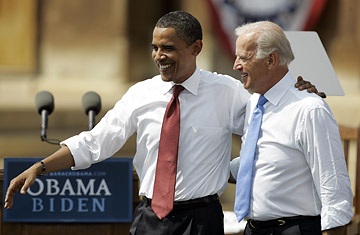
Barack Obama introduces his running mate Joseph Biden in Springfield, Illinois
An exclusive TIME/CNN/Opinion Research Corporation poll reveals that Barack Obama leads John McCain by several percentage points in three crucial battleground states—Nevada, New Mexico and Pennsylvania—while McCain tops Obama by 1% in Colorado.
Obama's widest margin is in New Mexico, where 53% of registered voters said they prefer the Democrat to 40% who favor McCain. Obama also holds a five-point advantage in Nevada (49% to 44%). Both states went narrowly to George W. Bush in the 2004 election.
In Pennsylvania, Obama leads 48% to 43, while McCain topped Obama in Colorado 47% to 46%. In all state polls, the margin of error is plus-or-minus 4%.
While the results are positive news for an Obama campaign that has seen the race tighten over the past few weeks, there are encouraging signs for McCain as well. In Pennsylvania, where Obama had a 12-point lead in the Real Clear Politics poll average as recently as June, the Republican senator has narrowed the gap to within one point of the margin of error. McCain also holds significant leads with white voters in all four states, ranging from an 8% advantage in Pennsylvania to 15% in Nevada. (Full results here.)
When the field of candidates was expanded beyond the major parties, it's clear that Ralph Nader could again have a significant impact on the Presidential race—though in highly unpredictable ways. In Nevada, Nader was the choice of 6% of respondents, and his presence flattened Obama's lead into a 41%-41% tie. Yet in New Mexico, where Nader polled at 8%, he drew votes almost equally from both major candidates, while in Pennsylvania he siphoned off significant support from McCain; a three-way race there would give Obama 47%, McCain 38% and Nader 7%.
The TIME/CNN/Opinion Research Corporation poll was conducted with sample sizes between 625 and 669 registered voters in each state between August 24-26. Some of the telephone interviews took place before the Democratic convention while others happened during the convention's first two nights, making it an incomplete measure of the event's effectiveness so far.
